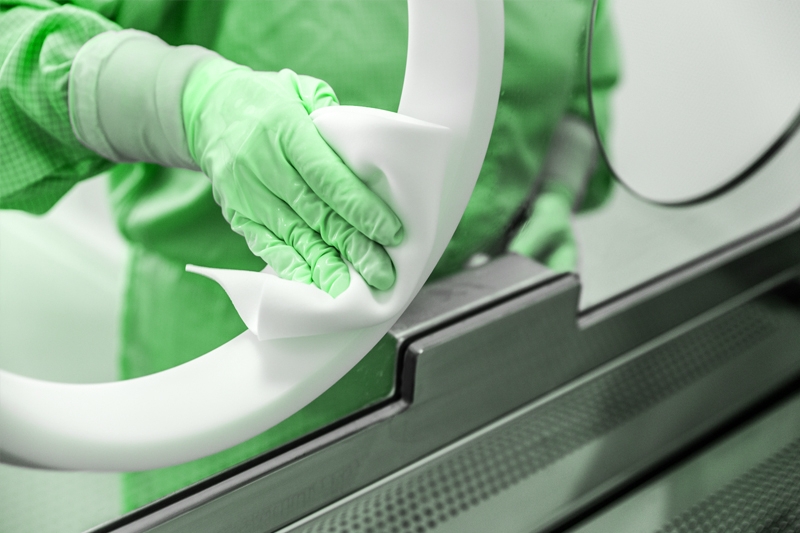STERILISATION
Dry Cleaning
For normal, everyday cleaning, dry cleaning, aka dry transfer, is a very common sterilisation technique—this manner of cleaning heads to polishing or wiping a surface with a collective cloth an absorbent. Different cleanroom-approved substances are perfect for this kind of sterilisation, but the one you prefer will depend on your cleanroom’s type. Just remember to make sure that the type of wipes you prefer for regular dry transfer cleanings are free of dust. This will decrease the quantity of dust and shreds dropped behind from the dry transfer cleanroom sterilisation. A dry transfer is generally used every day to eliminate the least quantity of particulate accumulation that happens in a brief period.
Wet Cleaning
Wet cleaning, the process of cleansing with a recommended solution or cleaning fluid, is essential when a regular dry transfer cannot eliminate the particulate collected with time – usually once a week. A variety of cleaning solutions are suitable for removing cleanroom dirt, but the one you pick for your cleanroom will depend on the surface and rating of your cleanrooms. It’s essential to note that you’ll want to choose merchandise approved by the EPA and by the Cleanroom industry in India. EPA-approved goods are often more reliable for your team, as they release less deadly fumes.
INSTATING YOUR CLEANING PROCESS
Before you start assigning employees to sterilise your cleanroom, you’ll first need to take a few initial organisational steps:
Standard Operating Procedure
You’ll require a clear, outlined plan for all types of cleanroom sterilisation methods you intend on implementing: daily, weekly, and monthly. This system will guarantee that all employees know precisely what they’re accountable for at each cleansing. Your SOPs should cover customary dilution methods for any cleansing solutions used and frame which order workers should clean surfaces and cleanroom accessories.
Training Your Team
After forming the required SOPs, it’s moment to train your employees liable for sterilising the cleanroom. It’s a great plan to have some selected employees who will constantly examine the cleaning to ensure that the process is consistent. Employees should know precisely what to do, starting from opening the cleanroom using sterilised cleaning products and tools to dump any trash after complete cleaning. By tutoring and constantly observing the team accountable for sterilisation, you’ll be able to guarantee a cleaner cleanroom.
EXTRA CLEANROOM STERILISATION TIPS
Start From Top to Bottom
No matter what sterilisation process you’re using, employees must always be clean from top to bottom. A precise monthly cleaning suggests that employees start with the roof, move to walls, and then work with tables and chairs, working their way to the floor.
Sticky Flooring
Many cleanrooms employ sticky flooring to reduce the quantity of particulate left in the cleanroom because of shoes and dust accumulating on the floor. It is a great method to maintain sterility of your cleanroom, but it will need a separate cleaning method. Assure that your Standard Operating Procedure involves precise manufacturer guidance on the cleaning method for this sticky flooring.
Preparation of Cleaning Materials
It is eminent that workers comprehend precise preparation methods for cleaning materials. In most cases, a water-diluted cleaning solution is safe to use on cleanroom surfaces. Incorrect dilution can lead to 1) inefficient cleaning processes if the dilution is too much and 2) the decay and deterioration of cleanroom surfaces if solutions are not sufficiently diluted. Most cleanroom sterilisation products are acidic and need a precise amount of dilution to guarantee that they remove only the bits that spoil your cleanroom and not destroying cleanroom surfaces. Double-check that the cleansing supplies you pick are well-suited for your cleanroom.
Beware of Fumes
Cleansing supplies can cause fumes, polluting your cleanroom and hurting employees. Guarantee that fans and filter systems are always left on when the cleanroom sterilisation process is taking place to duck fume build up.











